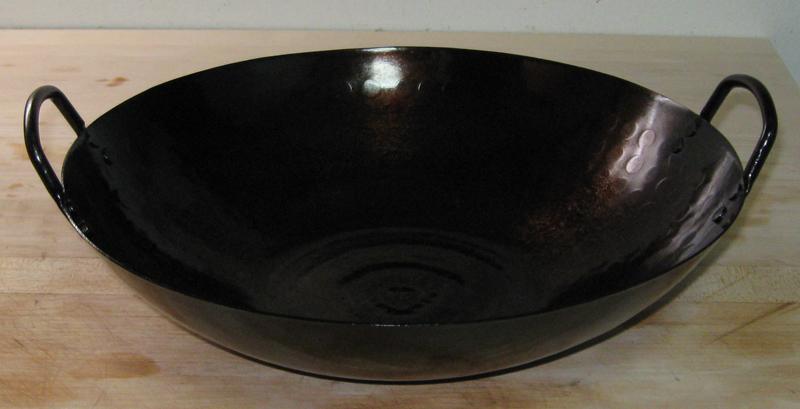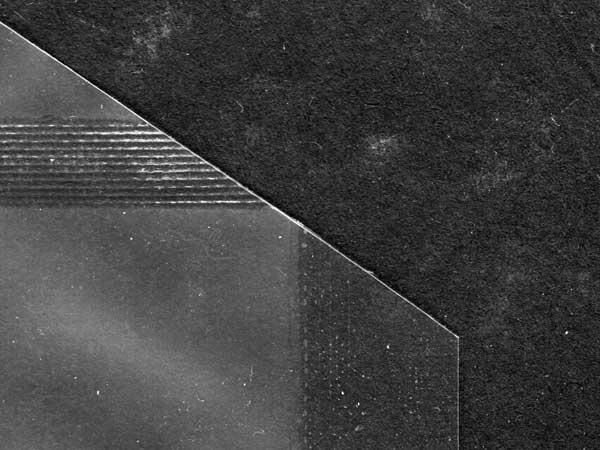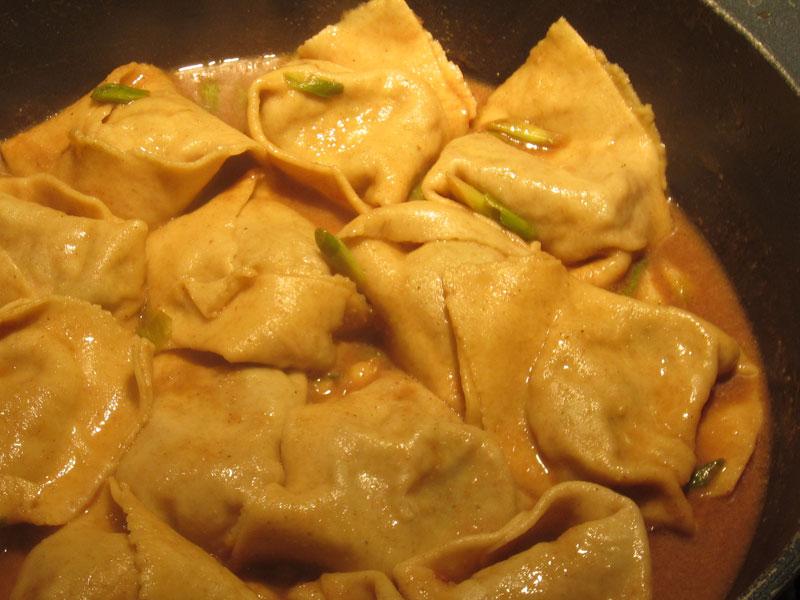-
Posts
303 -
Joined
-
Last visited
Content Type
Profiles
Forums
Store
Help Articles
Everything posted by Syzygies
-
Where's the bigolaro?
-
This is egullet. It isn't a crime to over think something here! And I'm so glad I found this thread, I really learned something from it. I'm reminded of wood working. They know what drying oils are, and elaborate discussions of esoteric wood finishes are routine. Along the same lines, one uses the same stones and skills to sharpen Japanese cooking knifes as Japanese woodworking tools, but the kitchen is considered the less critical application. Thank you! Anyone can say their favorite method works well, and it probably does. One can only make a comparison if one has tried both ways. Pictured is a brand new 14" flat-bottomed wok from the Wok Shop: http://wokshop.store...casthaw2me.html It arrived silver as shown in the link. I stripped any possible residue, then applied twelve coats of flaxseed oil. If one attempts to remove all oil from such a smooth surface, one leaves very little oil. Twelve coats (twice what the blog post recommends) seemed about right. I'm now deep-frying in it, the second phase to seasoning a wok. I have tried many approaches over the years. My Thai teacher swears by lard, which had been my favorite. I've never seen a finish like I obtained by this blog method. It got me excited enough to remember that my French teacher swore by carbon steel fry pans, and I have some on order: http://www.cooksdire...-steel-fry-pans (I'm aware that cast iron can be cheaper than the best carbon steel; it's a more primitive technology. I wanted the best carbon steel, and it came down to these pans or de Buyer.)
-
There is a way to bring sous vide PID control to your smoker: http://www.thebbqguru.com
-
It was the poster child for "remainder table cookbook" for decades, and many of us first learned to cook Italian from it. One can easily find it used for a song. Highly recommended.
-
The VP-215 has an oil pump. Better but more maintenance. (It's on my short list along with the MiniPack-MVS-20 which is more expensive.)
-
Are there any induction ranges with a thermometer port and a decent PID, building in the equivalent to a SousVideMagic? I use my SousVideMagic frequently with a dumb conventional hot plate (the induction hot plates that can be used with an outboard PID controller are very expensive). It astounds me that these PID circuits haven't propagated pretty much everywhere. It seems we're waiting for a generation of executives to retire.
-
Thanks, that's very interesting. I do also have a PID-controlled ceramic cooker (http://www.komodokamado.com) so I'll have to try this.
-

Cooking with "Burma – Rivers of flavor"
Syzygies replied to a topic in Elsewhere in Asia/Pacific: Cooking & Baking
One uses the flower (one of a few foods that can sometimes be past my threshold for bitter) frequently in Thai salads; Burma also calls for banana flowers, and distinguishes between them and stems. Stores that carry the flower may also carry the stem. My Thai cooking teacher (very highly recommended with a caveat: it's very hard to find Thai I can eat in the US now after eating in her classes and on her tour) maintains an actively updated site for Thai markets (and ingredients, etc.): http://www.thaifooda...om/markets.html The ones I've visited are sometimes run by other nationalities, and also cater more broadly to SE Asian needs. So this list could be a start... -
I can see one issue suggesting that your order is backwards: The brisket best absorbs smoke colder than 132F. In BBQ competitions people put very cold meat into a cold cooker to maximize smoke absorption and the telltale red smoke ring from the effects of the smoke. (Judges who are too bombed out from other contestants' smoke to taste anything look for this red ring as a proxy.)
-
If you ever get a chance to make these from scratch, go for it. They were my first dish, arriving at a friend's apartment in Genova on my first trip to Italy, and they blew my mind like few dishes do in a lifetime.
-
I'm looking to improve "snip the corner" (as I described in http://forums.egulle...31#entry1902431) as a practical method for using vacuum chamber bags without a chamber vacuum machine. This method has replaced any other approach for me, as I love these bags (I don't love FoodSaver or ZipLock bags), and I'm usually willing to involve enough liquid for the "Archimedes" (evacuate using water displacement) approach to work. However, there are times one wants to use a vacuum pouch without adding liquid. The basic principle I'm exploiting is that two films of plastic with the faintest bit of liquid between them makes a very effective check-valve. Once air leaves, it's not easily getting back in. Then one adds another seal using an impulse sealer, to prevent leaks. For a few hundred dollars one can put together a home vacuum chamber and outboard electric vacuum pump that can reach and hold 25 bar. For far less (which could appeal to the "ghetto sous vide" crowd) one can reverse bike pumps or 12V tire pumps and build one's own vacuum chamber. There's also always the FoodSaver canister route, but I doubt that's much of a vacuum. I'm thinking put dry food into a chamber pouch, very lightly wet or spray the upper inside of the pouch (cooking oil?), seal across the top and snip the corner, as shown in the photo. Now put the pouch in a vacuum chamber, create and hold a vacuum long enough to draw the air out of the pouch, and release the vacuum. I'm betting that the pouch will function as its own check valve long enough to seal it for good with an impulse sealer. Is anyone in a position to easily test this theory?
-
A Rancho Gordo blog post on cooking garbanzos in a pressure cooker: http://ranchogordo.typepad.com/rancho_gordo_experiments_/2013/01/garbanzos-in-the-pressure-cooker-im-almost-a-convert.html
-
I've been wondering about speeding and safeguarding the soaking process for salt cod or stockfish, using sous vide temperature control. Use a temperature that pasteurizes, without significant cooking? Change the water a few times, perhaps. Has anyone tried this? Stockfish in particular needs many days, best with running water, and I've lost every batch I've tried to soak at home, trying to recreate the defining dish of Nice, France. (One can buy stockfish presoaked on Arthur Avenue in the Bronx.)
-
A highlight of my first trip to Norway was visiting Kristiansund, which is Mecca for salt cod enthusiasts. One sees the stone hills where the cod was put out to dry. http://www.nordmore....back=1&MId2=259 http://www.slowfood....asso?-id_pg=211 http://forums.egulle...53#entry1647053 The sea trade brought home wives; even today one sees more beautiful black haired women here than anywhere else in Norway. I later met a woman at a conference who looked like Penélope Cruz but wore those odd Scandinavian cargo-pant bell bottoms, and I took a wild guess that she was from Kristiansund. Yes.
-
The original spirit of my remark was "something to watch out for." As in, consider this possibility if one is experiencing an unexpected anomaly using the proposed method. In any given cooking procedure, a few issues matter a lot, and most issues matter very little, and it is of utmost importance that the cook maintain perspective and apply intuition without getting lost in inconsequential details. Nevertheless, I've taught the heat equation and I can dream in the curves involved. You know those bell-shaped curves one sees everywhere? One way to produce a bell-shaped curve is to heat up one spot on a rod really hot, then come back later and graph the temperature along the rod. If one made a movie, one would see a family of bell-shaped curves spreading out over time, as the heat along the rod equalized. First, many people post-sear, in complete control of the aesthetic effect. If one pre-sears, that's an initial shock wave of heat that is reversed by the cold meat and/or chilling before using a chamber vacuum machine. Use a Thermapen or cut a cross-section and one sees that the part of this heat shock wave above one's target core temperature never gets very deep. If one throws a thick pork chop into a well-insulated container (such as the Zojirushi) computing temperatures to balance at equilibrium, then near equilibrium one will see a beautifully smooth temperature curve that is too cold across the middle portion of the meat, and too warm across the outside portion of the meat. The temperature curve over time will look something like two people picking both ends of a rope up off the ground, holding the sagging rope between them, and pulling tight. Once the rope is off the ground, the middle part of the rope is always lower than the outside part of the rope. (Gravity is not heat, and the heat equation is itself only a model. One quirk of this model is its prediction that the core starts to react to the application of heat instantaneously, faster than the speed of light.) Using the Sous Vide Dash application, one can ask to cook a 50mm pork chop to Medium (FDA Sugg.) 145 F, in a water bath held at 150 F. They call 150 F Medium Well. It takes two and a half hours for the core to reach 145 F, at which time the temperature curve smoothly rises from 145 F in the middle of the meat to 150 F at each surface. Roughly half of the meat is closer to Medium Well than Medium (something a restaurant client would notice) and has been at such temperatures a long time. With the passive equilibrium approach the effect is less, but similar. The cook takes longer. Much of the meat will be too warm for much of the cook. Is this a crisis? Of course not. It's simply closer to the effect of a conventional cook. When one looks at cross-sections of two steaks, and tries to guess which one was cooked sous-vide and which one was cooked conventionally, one is identifying these curves. The Sous Vide Dash application offered me a similar warning: Significantly is the key word here. However, in my initial remarks I discussed cooking as close as I could to the edge of a protein transition I wanted to avoid. I can't get as close with a bath warmer than my target temperature.
-
Scrambled eggs and overcooked meat are both examples of irreversible protein damage. The effect of a temperature overshoot on meat can be subtle, while the effect of a temperature overshoot on eggs so dramatic that everyone notices it. http://quoteinvestig...03/07/haggling/
-
Well, if we're using a spreadsheet, then we're debating whether the coefficient of the meat should be 0, 1.0, 0.8, or whatever. These are all approximations. If one is also fairly consistent about the equipment, the ratio of brine to meat and so forth, then most of the remaining error gets compensated for by one's personal choice of target salinity. On an ongoing basis, using 0.8 in one's spreadsheet is every bit as simple as using 1.0 as the meat multiplier, and 0.8 is a slightly better approximation. If one is already using 1.0 with good results, then it's K.I.S.S. to not think about it again. That doesn't imply that someone else should prefer 1.0 to 0.8, starting out. The effect is small, so pick some number, stick with it, and play to taste with one's target salinity, which matters a lot. When I overshoot just a little making crème anglaise, I get scrambled eggs.
-
http://theicecreambarsf.com http://www.sfgate.com/style/article/The-Ice-Cream-Bar-2963663.php They're rebooting the classic soda fountain, with influences from molecular gastronomy and cutting-edge cocktails. A good stop to refresh the palate, it was the hit of the day on one recent food crawl with friends.
-
The entirely parallel issue of brining meats is discussed at length in Paul Bertolli's Cooking by Hand. He guesses the water weight of the meat, and takes it into account in salting the brine, aiming for a target equilibrium salinity. Easy with a spreadsheet, but adoption in barbecue circles isn't universal. (Like cooks who proudly don't measure, there's this whole "Deliverance" angle to barbecue where one pretends one hasn't done arithmetic since dropping out of high school.) The computation is perhaps more critical for brining, because there's no device in the water that adjusts the water bath salinity. One could imagine an application like Sous Vide Dash computing your desired initial temperature. Weight is a reasonable first guess for thermal mass. If you have 1 Kg of carrots at 5 C, you need 10 Kg of water at 93 C to average 85 C: You're solving X*10+5*1=85*11. Where a calculation like this makes a lot of sense is with a totally passive method such as throwing a ziplock bag into a cooler filled with hot water, or with greater control, using something like the Zojirushi SN-XAE60XA Stainless Steel Thermal Vacuum Cooking Pot, 1-1/2-Gallon: http://www.amazon.co...n/dp/B004P489NM There one would want to also model heat loss during the cook. The cooler idea is entirely analogous to how people brine without a computation: Just use a huge quantity of brine, so the meat itself is insignificant, and the approximation given by ignoring it is reasonably accurate. Of course, if you don't have a circulator, you could just swish the contents a few times at the start, like stirring a pot. For meats, sometimes we're cooking just below a protein transition we're trying to avoid, and a water bath overshoot is something to avoid. A poorly tuned PID controller will offer an overshoot on its own, without our help!
-
Sous vide braised beef cheeks and fresh pasta from homeground flour, combined with the usual suspects to make Chinese dumplings. The soup-like sauce made from the braising liquid mostly absorbed into the dumplings. This was a "cook the dish you're imagining" night after returning Beyond the Great Wall to the library. Template: Turn a braise into dumpling filling, using the liquid to dress the dumplings. Lamb shoulder? The Chinese inflection is mandatory.
-
This isn't an issue using the "snip the corner" method with an impulse sealer: http://forums.egulle...31#entry1902431 I generally need a bit of stock later, so the liquid requirement is acceptable to me. The liquid does need sieving afterward; were one deliberately making stock one would blanch first as the Chinese do. These are awesome, required equipment in the BBQ community. Nothing else comes close. One can watch the readout change as the probe passes through a thin piece of fish, with meaningful results. They are worth the price.
-
Talk to these guys, they really know their tomatoes, and have a broad selection. Forni-Brown Organic Gardens http://www.epicuring...-april-mayfree/ My question for you: What did Italians do for tomatoes year-round before the debasing convenience of canning? Sun-dried tomatoes are fantastic for their intended purposes, but harsh as a substitute for fresh or canned; their US novelty uses are rather bizarre. Many US chefs, such as Keller, Colicchio, advocate some form of tomato conserve to heighten the flavor and preserve tomatoes for later use. Their methods are rather fussy and involved when one's crop is coming in 30 pounds at a time, and too targeted to be as broadly useful in, say, Indian cooking as Italian. We preserve our annual California crop (from Forni-Brown plants) 20 to 30 pounds at a time by blanching 45 seconds in boiling water, plunging into ice water, skinning, slicing onto dehydrator trays, sprinkling with sea salt, and partially drying. Rest a day in a bowl in the fridge to equalize moisture, then vacuum pack for a chest freezer. (A FoodSaver can manage the modest liquid present; we instead use chamber vacuum pouches and an impulse sealer, where the liquid is enough to squeeze the air out.) Italian-American families in the US still "can" (jar) their own tomatoes for each year. In Arthur Avenue, Bronx, New York one sees massive sales of crates of plum tomatoes each year for this purpose. A Neapolitan handyman in my New York apartment building found me drying Arthur Avenue tomatoes as described above, and now regales me each year with tales of how many jars his extended family puts up each year. I don't recall, but the number is staggering. Other US consumers got so adapted to the taste of "can" in canned tomatoes that when manufacturers first reformulated canning to minimize this taste, there was consumer revolt. I really don't like the taste of canned tomato in even moderately upscale restaurants. Were I involved in a restaurant, I'd bet the bank on some conservation technique like I describe above, to avoid having to buy commercially processed tomatoes. I mentioned Keller while discussing this at Forni-Brown, and I believe the response included "Tommy", which startled me. They're in Napa.
-
!! I bought the Grace Young kindle version moments before reading this. I'm fanatical about noodles and dumplings. I love the dumpling pictures in Dunlop, particularly handmade wrappers in the same spirit as southern Italian pasta making. I have all of Dunlop's books. I get home too late from work some weeknights to get into some of the involved recipes in her other books. This new book is filled with templates for food I want to eat, that one can generally make quickly.
-
Made General Tso's Chicken (Taiwan version) tonight from Revolutionary Chinese Cookbook: Recipes From Hunan Province by Fuchsia Dunlop. Rather than deep frying the chicken thighs, I cooked them sous vide at 150 F a couple of hours in a bit of stock, using the "snip the corner" impulse sealer method of http://forums.egulle...31#entry1902431. Filtered and reduced the stock, sliced and marinated the chicken then stir fried in a bit of lard. Very interesting "twice cooked" texture, and I vastly prefer the flavor of lard to that of peanut oil. Peasants didn't deep fry, they never had that much oil on hand, that's restaurant technique. Peasants rendered fat from the animals they slaughtered, and used it sparingly as the precious material it was. I like Chinese food this way, and I'm looking for other ways to work in sous vide technique.
-
$0.15 each, versus $0.09 each for chamber vacuum pouches that are heat safe. Get a $30 impulse sealer and play with these nicer bags. I'm never going back.




